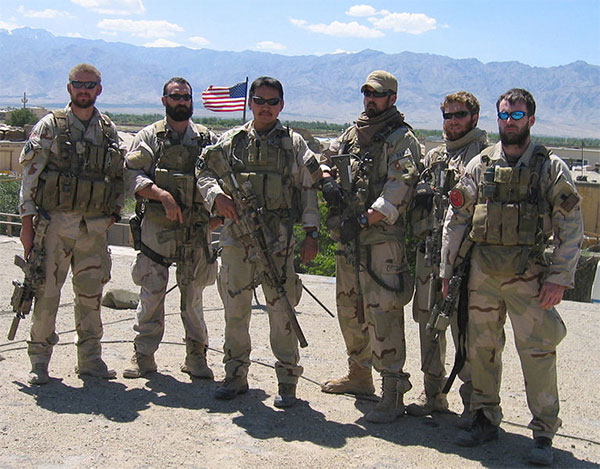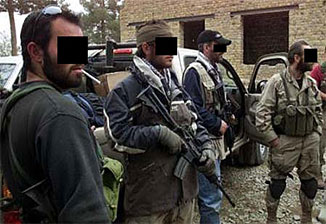Navy SEALs - Operation Redwing
On June 28, 2005, a 4-man SEAL patrol was on a mission in the Kunar Province, Afghanistan to kill or capture a high ranking Taliban leader, thought to be close to Osama Bin Landen.
The SEAL's quarry was believed to be holed up in a village near Asadabad, close to the border with Pakistan, protected by over a hundred fanatical Taliban fighters. The SEALs planned to establish a observation post (OP) high up on the slopes of a mountain that overlooked the village. They would confirm the presence of their target, gather intelligence on the Taliban forces in and around the village. If they had the opportunity they would take out their target with a sniper shot.
![]() Kunar Province, Afghanistan (google earth kmz file)
Kunar Province, Afghanistan (google earth kmz file)
Under the cover of night, the 4-man SEAL was inserted high up in the mountains by a MH-47 flown by the Army's elite 160th Special Operations Aviation Regiment. The team consisted of 3 petty officers, Matthew Axelson, Danny Dietz and Marcus Luttrell and was led by Lt. Michael P. Murphy. This recon team were from Alfa platoon, SDV Team 1, seconded to SEAL Team 10, who were operating out of Bagram airbase. The SEALs had been on a number of previous operations in the Hindu Kush mountains. Taliban and Al Qaeda forces regularly sought refuge in these almost impassible mountain ranges and the SEALs had been sent in to hunt them down.
![]() Bagram Airbase (google earth kmz file) |
Bagram Airbase (google earth kmz file) | ![]() Hindu Kush Mountains (google earth kmz file)
Hindu Kush Mountains (google earth kmz file)
On this mission the SEALs carried spotting scopes and cameras with telephoto lenses, secure communications gear, claymores, at least one cell phone and a couple of days worth of food and water. 2 of the SEALs carried the MK12 Sniper Rifle. They all carried plenty of ammunition.
Moving slowly over the difficult, barren terrain, the SEALs eventually found a spot that would give them a good view down onto the village. There was very little cover on the side of the mountain but the SEALs hid the best they could.
Sometime after sun up, the SEALs were discovered by a small group of goat herders who had walked right into the OP. The SEALs were now faced with a dilemma: do they execute the goat herders or let them go? In decision that would haunt the mission's sole survivor, the SEALs decided to let the goat herders go, knowing full well there was a good chance they would alert local Taliban forces to the SEAL's presence on the mountain.
In an attempt to stay ahead of the Taliban, the SEALs switched to an alternate OP and resumed their mission. A few hours later, they were approached by a large force of Taliban fighters. Surrounded left, right and forward, with a sheer drop down the mountainside behind them, the SEALs had no option but to try and fight their way out and so they opened fire.
A fierce and prolonged firefight ensued. The SEALs were unable to raise their HQ on their radio so were unable to call for backup. With more Taliban coming at them, the SEALs made a series of fighting withdrawals, moving down the dangerously steep mountain walls, pursued all the while by the relentless Taliban fighters.
All but one SEAL was unwounded by Taliban gunfire. Their situation was getting desperate. They still had no comms with their base and the Taliban kept on coming, no matter how many the SEALs felled. In a selfless act, the team leader, Lt. Michael P. Murphy, took out his cell phone and moved out into the open in order to get a connection to the HQ. Exposed, Murphy was gunned down by the Taliban but not before he was able to send out a brief distress call.
Forced to retreat further still, disaster again hit the SEALs as petty officers Matthew Axelson and Danny Dietz were both killed in action. The sole surviving SEAL, petty officer Marcus Luttrell fended off his pursuers while trying to get to safety.
Meanwhile, a rescue force of SEALs had loaded into a MH-47 Chinook helicopter at a QRF base established at Asadabad and were now flying into the area in a bid to rescue their brothers. Unfortunately the Taliban were ready for them and as the huge helicopter came into a hover over the SEAL's planned insertion point, a RPG was fired straight through the Chinook's open rear ramp. The rocket struck the internal fuel tanks and the helicopter exploded and crashed in a ball of flame. 8 SEALs and 8 Night Stalkers were killed. The only upside of this tragedy was that it had diverted many of the Taliban pursuing the original SEAL team away to engage it.

As both other US helicopters and the Taliban searched for him, Luttrell, himself now wounded, moved slowly down the mountain. Having lost his backpack, which included his water, in the initial contact, Luttrell was dangerously dehydrated. He eventually eluded his hunters after taking out a Taliban sniper and spotter team. Luttrell had traveled over 7 miles away from the site of the initial contact when he was discovered by locals from a nearby Pashtun village. After some deliberation, the village elders decided to give Luttrell shelter, hiding him from the Taliban, a move that put everyone in the village at great risk of reprisal.
Over the coming days, Luttrell was given food and medical aid by the villagers. He was eventually able to make contact with a force of Green Berets and Rangers who had been looking for him, who called in choppers to take them all home. The bodies of Luttrell's team mates were also recovered.
Luttrell was eventually awarded the Navy Cross for his courageous actions during Operation Redwing. His fallen brothers in arms were also honored. Matthew Axelson and Danny Dietz were posthumously awarded the Navy Cross whilst Lt. Michael P. Murphy was awarded the Medal of Honor, the highest military decoration awarded by the United States government, for his selfless act on that mountainside.
Featured Book: Highly recommended. |
Operation Redwing - Resources
- Two SEALs Receive Posthumous Navy Cross Awards
(American Forces Press Service story)





